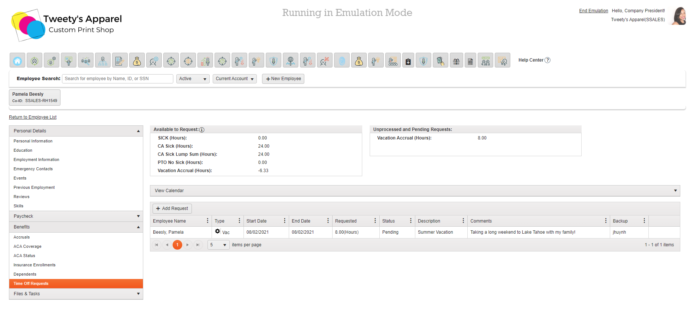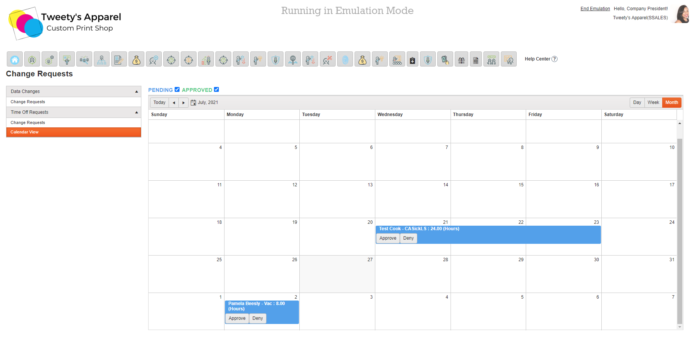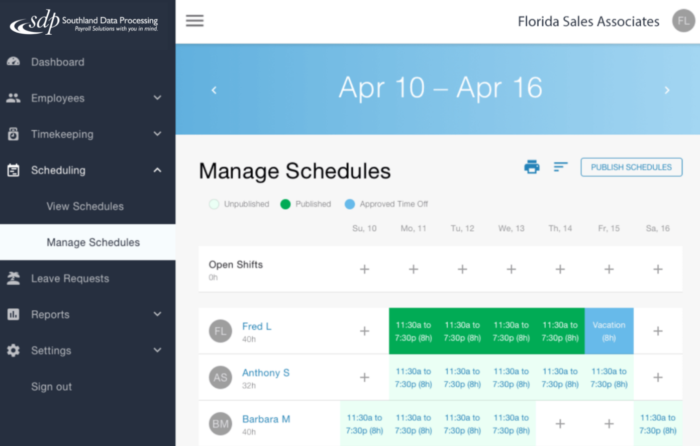
With summer in full swing, most employers are receiving an influx of time off requests as workers plan their summer vacations. Unfortunately, this can lead to a whole laundry list of HR and compliance questions as you navigate what you “can” and “can’t” do. In this article, our HR Team has put together the top questions we hear about vacation time and PTO, and what you should know to keep your business compliant.
1. Can we give employees different amounts of vacation or PTO time?
If the differing amounts of vacation or PTO are based on clearly defined employee groupings (i.e. seniority, department, or exempt versus non-exempt status), then yes.
For example, it’s common practice for employers to offer more vacation time to employees who have been with the organization for longer.
Where you can run into trouble is offering different amounts of vacation on an individual basis or without clearly defined criteria. Either of these practices can lead to discrimination claims.
For instance, if an employer hires Rafik and Anita at the same time for similar jobs in the accounting department at the same rate of pay, but offers Rafik more vacation, Anita could potentially bring a claim under federal or state discrimination or pay equity laws.
2. Can we ask for more detail when an employee marks “personal” for the reason they’re requesting a vacation day?
You can generally ask employees to provide more information when they indicate that their vacation or PTO request is for personal reasons. However, we don’t recommend it.
The specific reasons for the day off shouldn’t affect whether you grant the request. Further, you don’t want to give the impression that you’re accepting or denying requests based on the reasons that are given. It may also be information an employee doesn’t want to share.
If the time off requested is problematic for scheduling and you’re trying to assess whether the employee could take off a different day/time (or if the company should grant the request despite the inconvenience), we recommend having a conversation with the employee rather than digging for details without telling them why you’re asking.
Top Tip: The above only applies to time off that you offer as a company benefit. Time off that is required by federal, state, or local law will have its own requirements about what you can or cannot ask.
3. Can we deny an employee’s use of accrued vacation time?
Yes, the decision to approve or deny the use of accrued vacation time is up to you, assuming you do so in a consistent and non-discriminatory manner.
For example, it would be acceptable to deny a vacation request that would leave you without adequate coverage or if the employee asked with less notice than is required by your time off policy.
However, as an employer, it’s important to remain vigilant to avoid denying certain employees’ vacation disproportionately. For instance, if an employer’s administrative staff (who are all women), or their software engineers (who are all men), are consistently denied vacation because arranging coverage is difficult and deadlines are abundant, this could lead to claims of discrimination.
4. Say I have a non-exempt employee who uses PTO one day and then works longer shifts the rest of the week. Their timesheet adds up to more than 40 hours–do I have to pay overtime?
Overtime pay depends on the number of hours the employee actually worked during the workweek. At the federal level, under the Fair Labor Standards Act (FLSA), employers only need to pay overtime when hours worked exceed 40 in a workweek.
You should therefore do your overtime calculations without considering paid time off hours. Paid time off can always be paid at straight time.
Here’s an example:
Non-exempt employee John uses 8 hours of PTO on Monday. Then, he works 8 hours per day Tuesday through Saturday. In this situation, John’s employer does not owe him any overtime because he performed work for only 40 hours that week. His employer should pay all 48 hours at straight time.
However, if John uses 8 hours of PTO on Monday, then works 9 hours per day Tuesday through Saturday, he would be owed 5 hours of overtime because he performed work for 45 hours that week. His employer should pay 48 hours at straight time and 5 hours of overtime.
Top Tip: Keep in mind that a handful of states (including California) have their own daily overtime rules. Those rules follow the same principles, though. You only need to look for overtime when an employee’s actual hours worked exceed the legal threshold.
5. A non-exempt employee is demanding pay for an hour she spent checking work email while on vacation. We didn’t request, require, or authorize this work. How do we handle this?
Although you didn’t give this non-exempt employee permission to check her work email while she was on vacation, you will need to pay her for the time she worked.
In this case, the employee checked e-mail for one hour of her vacation day. Therefore, you should pay one hour of regular pay and charge the rest of her day to her vacation bank.
To prevent this kind of situation in the future, it is perfectly permissible to create and enforce a policy stating that employees are not permitted to perform work (including checking e-mails and voicemails) while on vacation or taking any other kind of paid or unpaid leave.
While you can’t withhold pay for time worked, you can hold employees accountable to the policy by disciplining them for any violation.
6. What is the minimum amount of time a salaried exempt employee must work to be paid for the entire day?
If an exempt employee does any work, you must pay them for the full day—there is no minimum.
For instance, say you have an employee come to the office for the first 15 minutes of their usual 8-hour day and then go home sick, or who worked the first half of the day and then left early for a social event. In either case, they would still be entitled to their full pay for that day.
The only exceptions to the Full-Pay-for-Partial-Day rule are:
- During the employee’s first or last week of employment
- When the employer is offsetting amounts received for civil service like jury duty or military leave
- When the employee is taking unpaid leave under FMLA
However, employers can use an employee’s PTO to fill in the gaps. So, if that employee had paid time off available in their PTO bank, the employer could use a partial day of that time to cover their absence.
Just keep in mind that if the employee does not have any PTO, you will still owe them for the full day.
Time Off Requests in SDP Connect
If you’ve been managing time-off requests through Excel or Outlook, there’s a better way. When you enable Employee Self-Service (ESS) in SDP Connect, you gain access to our integrated Time Off Requests. Employees can make requests directly from their Employee Portal:

Then, our system will notify your company Admins. From their Administrator portal, they can view the employee’s accrual balances and approve or deny directly from the system:

If you need something a bit more comprehensive, our automated timekeeping system SDP Time has you covered. In addition to accrual balances and time-off requests:
- Employees can clock in and out of shifts
- Managers can import hours into payroll with the click of a button
- You can minimize legal risk with meal and break compliance
Finally, businesses with multiple locations, schedules that change frequently, or a large number of hourly employees can benefit from SDP Scheduling. Our advanced scheduling software allows you to build schedules in minutes with our drag-and-drop editor.
And if an employee is taking PTO, they can post to the shift-swapping board. That way you don’t need to waste time finding a replacement. All you have to do is approve the swap!

Let’s Talk
Between compliance questions and employee scheduling, time off requests can be tricky! No matter your situation, SDP has workforce management solutions for any business size and budget. Let us know if you’d like to schedule a quick call to find the right fit for your business!
Additionally, if you need help updating your employee handbook or staying compliant with wage and hour laws, our HR team is here to help. You can learn more about our HR Support Services here.
Finally, don’t forget to follow us on Facebook, Twitter, and LinkedIn for even more business tips & news!
Photo by Andrea Piacquadio from Pexels
*Southland Data Processing, Inc. (“SDP”) is not a law firm. This article is intended for informational purposes only and should not be relied upon in reaching a conclusion in a particular area of law. Applicability of the legal principles discussed may differ substantially in individual situations. Receipt of this or any other SDP materials does not create an attorney-client relationship. SDP is not responsible for any inadvertent errors that may occur in the publishing process.
